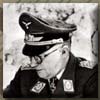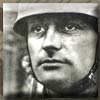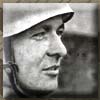| With the surviving Allied forces withdrawn to Crete, the Germans
decided upon an air-landing operation to capture the island.
Operation Merkur (Mercury) would use the 7th Air Division to
capture airfields on Crete, then German mountain troops from
5. Gebirgs-Division would be flown in as reinforcements. The
7th Air Division began parachuting onto the island on May 20,
landing as follows: * Maleme - Luftlande-Sturmregiment (Generalmajor
Eugen Meindl); 3. Kompanie (Oberleutnant Wolf von Plessen),
4. Kompanie (Hauptmann Kurt Sarrazin)/ I. Battalion HQ(Major
Walter Koch), and a regimental HQ force of the Luftlande-Sturmregiment
under Major Franz Braun. All of these forces landed by glider,
with Von Plessen and Braun's detachments successfully landing
in the river bed, securing the Tavronitis Bridge, destroying
nearby anti-aircraft batteries and gaining a foothold in the
RAF camp at Maleme airfield, although both commanders were
killed. Koch and Sarrazin's detachments came down on the southern
slope of Hill 107, directly onto the positions of A &
B comapnies, 22nd New Zealand Infantry Battalion. They suffered
heavy casualties with Sarrazin killed and Koch wounded in
the head, whilst the survivors were scattered across the hillside.
The rest of the forces dropped at Maleme were all part of
the Luftlande-Sturmregiment and jumped from Ju-52 transport
aircraft. These forces consisted of:
* II. Battalion/ LLSR (Major Edgar Stentzler); This battalion
landed unscathed around Rapaniana, with one platoon under
Leutnant Peter Mürbe being dropped further west to secure
an unfinished airfield near Kastelli.
Meindl later sent 5. (Oberleutnant Herterich)& 7. Kompanie
(Hauptmann Barmetler) to attack Hill 107 in a flanking maneuvre
from the south.
* III. Battalion/ LLSR (Major Otto Scherber); The 3rd battalion
dropped in the area east of Maleme airfield, right on top
of the New Zealand defensive positions south of the coastal
road.
The battalion suffered high casualties with many Fallschirmjäger
being killed as they came down and struggled out of their
harnesses, or whilst searching for weapons containers. Nevertheless,
small groups of survivors went into action and carried out
hit-and-run attacks on enemy positions or held their ground
against local counterattacks.
* IV. Battalion/ LLSR (Hauptmann Walther Gericke); 4th battalion
landed in good order west of the Tavronitis river together
with II. Battalion. Only the 16. Kompanie (Oberleutnant Höfeld)
landed elsewhere, namely south of the main force near Polemarhi,
to act as a flank guard.
* Canea and Suda Bay - 3rd Regiment
* Retymnom - 1st and 3rd battalions of 2nd Regiment
* Herakleion - 1st Regiment; 2nd battalion of 2nd Regiment
During the approach, General Süssmann was killed and
General Sturm assumed command. The Allied forces on the island
put up a stubborn defense and the troops of the 7th Air Division
took heavy losses, with over 6,700 killed and wounded out
of 22,000 men. With the aid of the follow-on reinforcements,
however, the Allies were forced to evacuate the island by
April 29.
In August 1941 the 7th Air returned to Germany. The invasion
of the Soviet Union was now underway, but the Division would
play no role during the first summer. The losses suffered
in the Crete landings were made good with newly trained recruits,
and by September 1941 the Division was back up to strength.
On September 24 the Division received orders to move to the
Leningrad front in Russia.
As in past campaigns, the élite 7th Air Division was
again frequently to be used in Company and Battalion-strength
units, patching up battle lines whenever the German defenders
started to waver against Soviet attacks. This experience led
the Paratroopers to name themselves "The Führer's
Firemen".
Beginning September 29, the 1st and 3rd Regiments of the
7th Air Division joined the defense of the salient along the
Neva River. The battle continued into the first Russian Winter,
with units taking heavy losses during the conflict. Finally
in mid-December the Division was relieved and returned to
Germany.
Meanwhile in November the 2nd Regiment was deployed to the
southern sector to participate in the defense against the
Russian winter offensive. They remained on the front throughout
the winter, suffering more from the difficult climatic conditions
than from enemy actions. By March 1942 the 2nd Regiment was
posted to the Volkhov front, to the southeast of Leningrad,
defending against the fierce and continuing Russian attacks.
When the 2nd Regiment was returned to Germany in June, 1942,
it was detached from the 7th Air Division and would form the
nucleus of the German 2nd Parachute Division.
The 7th Air Division was now recovering in Normandy, France.
To replace the 2nd Regiment, the 4th Parachute Regiment was
raised and merged into the Division. Later in the year, plans
were made to use the Division in the German summer offensive
in Russia. However the operation was cancelled, and the Division
was deployed in the Rzhev sector near Smolensk in October.
Much of the winter months were spent patrolling and performing
limited attacks along the front. The battle of Stalingrad
was underway, and Soviet attentions were focused on the southern
part of the front. This situation changed in March 1943 when
the Soviet army assaulted the Divisional front. This attack
was beaten back with heavy Russian losses.
By May the Division had returned to Germany, after being
used to form the 1st Fallschirmjäger, or Parachute Division.
The formation was then moved to Avignon, France for rest and
refitting. Their brief respite came to an end in July, however,
when the Allied forces landed in Sicily on July 10.
Most of the Division was moved to Catania airfield starting
July 12 to participate in the defense of the island. Again
the division was used in fire-brigade fashion, stiffening
the defenses wherever they started to waiver. As the decision
was made to withdraw, the 1st Parachute Division was employed
as the rearguard defenses as the evacuation proceeded. They
were the last German unit to leave the island on August 17.
For the remainder of the war the Division would fight during
the Italian Campaign. They were employed piecemeal to ward
against the possibility of sea-landings from Salerno to Taranto,
and fought another withdrawing action up the Adriatic coast
of Italy against the advancing Allies. By Winter the Division
was concentrated in the defense of the Gustav Line south of
Rome, defending against the advance of the British Eighth
Army under General Montgomery.
On January 1944, the US IV Corps made an amphibious landing
at Anzio, about 50 kilometers south of Rome. Unfortunately
for the Allies the landing quickly bogged down and failed
to advance. To support the landing, the Allied armies in the
south needed to break through the German defenses of the Gustav
Line.
In February 1944, the 1st Parachute Division was pulled out
of the line and shifted to the defense of Monte Cassino. This
dominant position laid astride the road to Rome, and must
be taken by the Allies if they were to advance. The Division
put up a ferocious defense of the site, which even carpet
bombing of the Monte Cassino Abbey on March 15 failed to dislodge.
The battle was finally broken off on March 22.
"No other troops in the world but German paratroops
could have stood up to such an ordeal and then gone on fighting
with such ferocity" — Field Marshal Alexander.
During the fight the Division took many losses, including
the 3rd battalion of 1st Regiment. However the Allies would
not resume their attack until May 11, and the Division had
time to make good its losses.
When the attack resumed with the third battle of Cassino,
the German defenses held out until May 17 before the line
became flanked along the coast by superior Moroccan mountain
commandos. This made the fighting for Cassino irrelevant,
so the 1st Parachute Division joined a general German withdrawal
to the north of Rome. On May 18, the 12th Podolski Lancers,
a Polish Unit from 3rd Carpathian Infantry Division, took
the monastery, which it found deserted, save for some remaining
wounded soldiers. The paratroops performed delaying actions
against the Allies until they reached defensive positions
in the Apennine Mountains to the south of Bologna. They now
formed part of the German I Parachute Corps, along with the
German 4th Parachute Division. The Italian front remained
static throughout the winter months, with only sporadic patrols
and raiding actions.
By January 1945, the German I Parachute Corps was deployed
to the Adriatic coast behind the Senio Rivier. The Allied
advance resumed on April 8, and the 1st Parachute Division
was forced into a steady withdrawal toward the Po River by
the British Eighth Army. By April 25 the Division had completed
the river crossing. They immediately set off on a final march
toward the Alpine Mountains.
Finally the German surrender in Italy came on May 2, 1945,
and included the men of the 1st Parachute Division. The unconditional
surrender of Germany followed a week later. |




